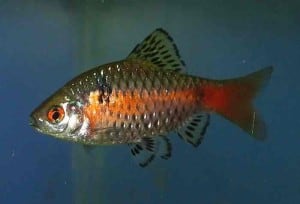
Common name: Odessa Barb, Ticto Barb, Scarlet Barb
Scientific name: Puntius Ticto, Puntius Padamya
Average Adult Fish Size: 4 inches / 10 cm
Place of Origin: Native to Southeast Asia; from the Himalayas to Thailand. Its’ native region include Bangladesh, Bhutan, China, India, Laos, Myanmar (Burma), Nepal, Pakistan, Sri Lanka and Thailand. Odessa barbs live in the upper Mekong, Mekong, Irrawaddy and Salween, as well as in the upper parts of the Chao Phraya basin.
Typical Tank setup: Well planted tanks with rock work and/or bogwood/driftwood. They come from very slow moving waters and do not prefer much current.
Recommended Minimum Aquarium Capacity: 20 gallon / 80 litre
Compatibility: They need to be kept in groups of 6 or more fish. Though generally peaceful, they may nip at long flowing fins of slower fish.
Temperature: 65 – 72 Deg F / 14 – 22 Deg C They are well suited for unheated indoor aquariums.
Water chemistry: pH 6.5 – 7.0
Feeding: They are omnivorous and do very well on a varied diet of high quality flake food, small pellets, frozen and live brine shrimp, daphnia, brown worms and frozen beef heart.
Sexing: There are no noticeable size difference between males and females, but the males have slimmer bodies. The Odessa Barb has a light brown body color and the sides of the fish are decorated with two black spots. The black spots are more distinct in males. Both sexes can display red-brown banding. In sexually mature males, the red-brown band will turn into a thick bright red band that starts at the tip of the mouth, proceeds through the eyes and continues down the side to the tail. During the breeding period, it is also common for the male to display more intense body coloration than normal.
Breeding: The wild Odessa Barbs a highly prolific and has a minimum population doubling time of less than 15 months. The Odessa Barbs are egg scatterers and they do not engage in parental care. Approximately 150 eggs will be released in batches of roughly 20 at a time. After one day, the eggs will hatch. The fry will be then become free swimming within 24 hours.
If you want to breed Odessa Barbs in captivity, you should ideally keep them in a well planted aquarium. As mentioned above, they are egg-scatterers that do not raise their young, and will not hesitate to eat their eggs and/or fry. If you want to ensure a high fry survival rate, you can set up a special fry raising aquarium and remove the adult fish after spawning. If you do not wish to arrange a separate aquarium, you can let the Odessa barbs spawn in their normal aquarium but make sure that it is very densely planted with bushy aquatic plant species that will create a lot of hiding spots for the young. Java fern is one example of a suitable plant. A lot of eggs and fry will still be eaten, but at least a few specimens will usually survive into adulthood.
During the spawning, the male and female Odessa Barb will swim to a planted part of the aquarium and the female will scatter the eggs among the plants. It is common for Odessa barbs to spawn during the early morning. The female will release around 20 eggs, the male will fertilize them, and the female will proceed to lay yet another batch of roughly 20 eggs. This will continue until around 150 eggs have been released and fertilized; a process which can take several hours
As mentioned above, Odessa Barb fry usually hatch after one day and become free swimming the next. When they have become free swimming, you can start feeding them newly hatched brine shrimp. Even though the fry is small at this stage, they can usually manage to devour newly hatched brine shrimp. As the fry grows larger, you can feed them bigger and bigger brine shrimp. If you keep your Odessa Barb fry on a nutritious diet and keep the water quality up, they will grow very fast. The two distinctive spots will start forming when they are about a month old.
Additional Information: The Odessa Barb is a beautiful aquarium fish, but less well known than its famous barb relatives like the Cherry Barb and the Rosy Barb. The Odessa Barb can still be tricky to find in ordinary pet stores and you might have to visit a fish auction, contact a breeder directly or purchase them over the Internet.


Related Posts
Croaking Gourami – Trichopsis vittatus
Benthochromis Tricoti
Large-eyed Mouthbrooder – Callochromis Macrops